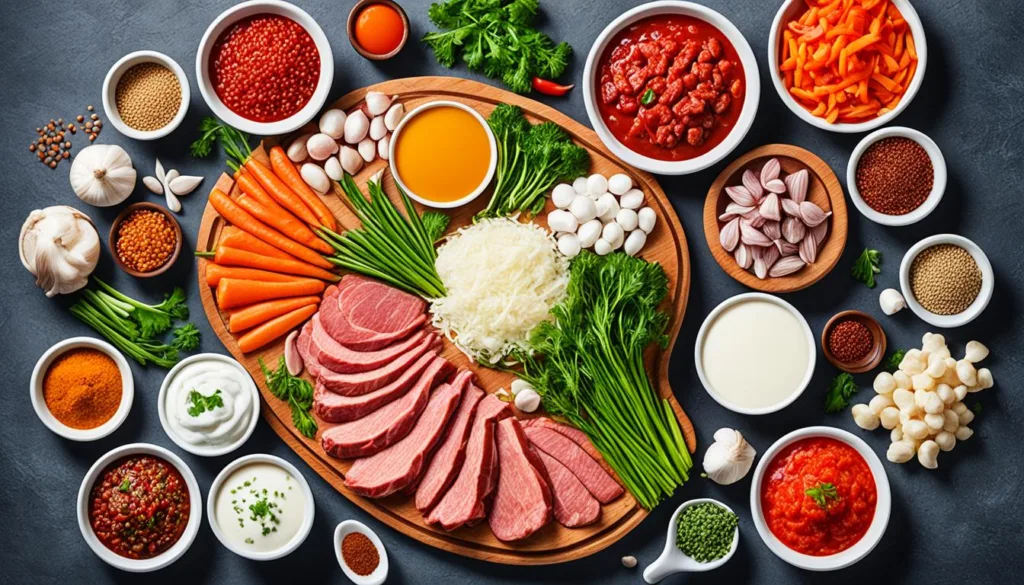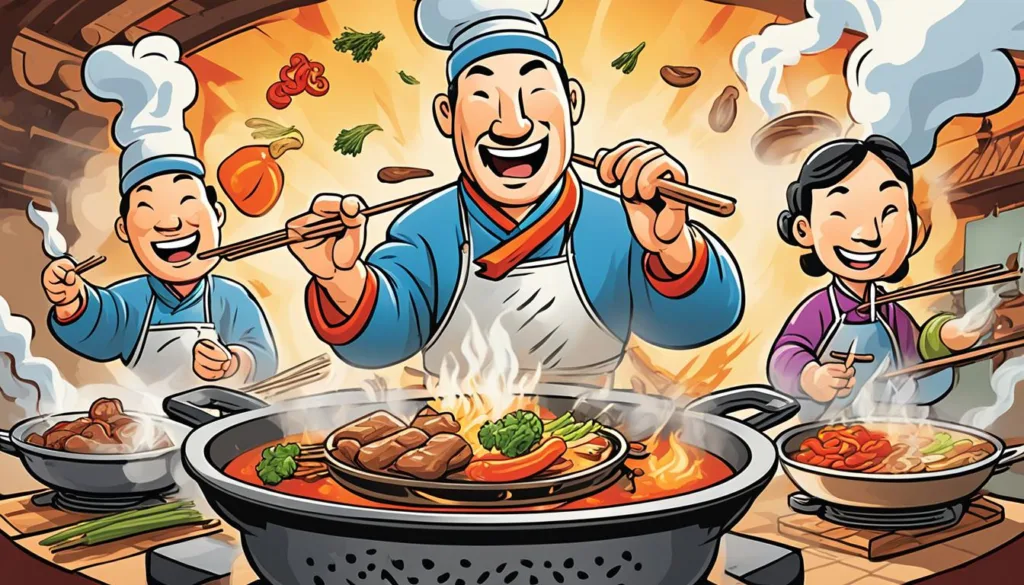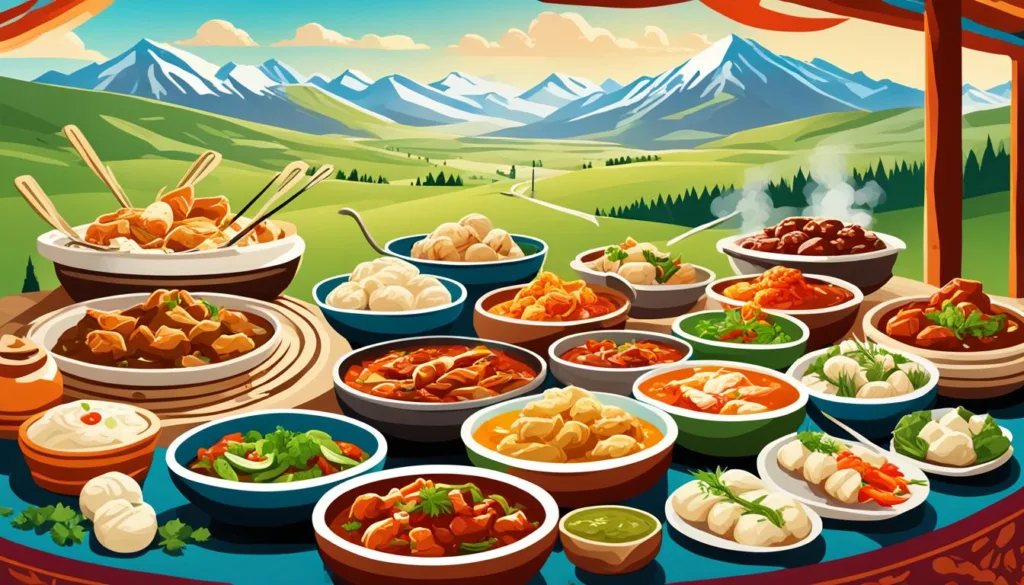Embark on an enthralling Mongolian Culinary Journey that extends far beyond the steppes and into the heart of an undiscovered gastronomic haven. Within the rugged terrains and the nomadic tapestries of Mongolia lies a world where the simplest ingredients transform into traditional Mongolian dishes brimming with robust flavors and rich history. By fusing time-honored practices with influences from Chinese, Russian, and Central Asian cuisines, Mongolian recipes offer more than just sustenance—they offer a narrative woven into every delectable bite.
Key Takeaways
- Discover Mongolia’s diverse flavors and hearty cuisine, influenced by its historical nomadic lifestyle.
- Learn why meat and dairy are pillars of traditional Mongolian food culture.
- Explore the significance of regional Mongolian recipes and how each dish tells a story.
- Understand how Mongolia’s vast landscapes and lifestyle contribute to its unique culinary identity.
- Recognize the Mongolian culinary traditions that could be poised to influence the global food scene.
Embarking on a Mongolian Culinary Journey
An exploration of Mongolian food culture is a voyage into vast, untamed culinary landscapes, guided by storied Mongolian cooking techniques and a rich palette of Mongolian ingredients. The traditional dishes of Mongolia not only provide sustenance but also tell a tale of the nation’s nomadic roots and its crossroads of Asian influences. As you delve into the hearty flavors, each meal unfurls the identity and essence of Mongolian heritage with pride and tradition at the forefront.
At the heart of this journey are quintessential offerings like Buuz—succulent dumplings steamed to perfection—and the formidable Khorkhog, a dish that exemplifies Mongolian barbecue, cooked with scalding stones. These much-celebrated favorites are not simply meals; they are an invitation to experience the communal bond and generous hospitality inherent within Mongolian society. Nonetheless, the culinary adventure does not end with these well-known treasures; it is in the lesser-known, equally enchanting meals such as Tsuivan, a delectable noodle stir-fry, or Boortsog, a crispy fried biscuit, that the full spectrum of Mongolia’s food legacy can be appreciated.
- Mongolian ingredients: A testament to resilience, featuring protein-rich meats and vibrant dairies
- Mongolian cooking techniques: From the nomadic steaming of dumplings to the communal joys of stone barbecue
All these dishes not only fill the stomach but also warm the soul, each bite a step further into the past and present of this storied land. Whether through the simplicity of the ingredients or the complex flavors achieved through centuries-old cooking techniques, the narrative of Mongolian cuisine is an unmissable feast for the senses.
Fundamentals of Mongolian Cuisine: Sourcing the Right Ingredients
The rich tapestry of traditional Mongolian dishes is woven from the hearty ingredients of the region’s vast steppe and nomadic culture. Understanding the source and role of each ingredient is key to appreciating the deep flavors and culinary wisdom embedded in Mongolian recipes.
Mongolian Meats: More than Just Mutton
Intricately linked to the nomadic lifestyle of the Mongolian people, meat is a quintessential element of their diet. As crucial suppliers of warmth and energy through the harsh winters, meats like beef, goat, and horse complement the ubiquitous mutton, each imparting distinct texture and flavor to Mongolian food traditions.
The Role of Dairy in Daily Mongolian Dishes
The versatility of dairy in Mongolian cuisine is remarkable, featuring in both savory and sweet treats. From the frothy airag to the comforting suutei tsai tea, dairy products carry with them the essences of both culture and nourishment, crucial for the sustenance of the nomadic people.
From Ground to Grain: Flour’s Place in Mongolian Recipes
Flour emerges as a culinary staple within the realms of Mongolian cookery. It is the foundation of the dough that encases fillings for delectable dumplings, and it is rolled out for the hearty noodles adorning the tables of many Mongolian families.
Rooted in Tradition: Vegetables in Mongolian Cookery
The harsh climatic conditions may not favor an abundant variety of produce, but essential vegetables like onions, potatoes, carrots, and cabbage are ingeniously incorporated into Mongolian recipes, infusing them with essential nutrients and subtle flavors.
| Ingredient | Primary Use | Dishes | Nutritional Value |
|---|---|---|---|
| Mutton | Protein Source | Khuushuur, Buuz | High in Protein and Zinc |
| Dairy | Beverages and Condiments | Airag, Suutei Tsai | Calcium, Probiotics |
| Flour | Bases for Dumplings and Noodles | Tsuivan, Boortsog | Carbohydrates, Iron |
| Vegetables | Supplemental Nutrition and Flavor | Stews, Salads | Vitamins and Fiber |

Essential Mongolian Recipes and Dishes
The crux of Mongolian cuisine is its profound emphasis on hearty and substantial meals, a true reflection of the country’s storied Mongolian food traditions. Immerse yourself in the delights of Mongolian dining with an exploration of signature dishes, each brimming with the rich flavors of locally sourced Mongolian ingredients.
The venerable buuz, a dumpling treasure filled with meat, is more than food; it’s a ceremonial offering signifying hospitality. Khorkhog, often at the heart of social gatherings, comprises mutton cooked with stones, invoking the raw natural essence of Mongolia. Let’s not forget tsuivan, a stir-fried marvel, and boortsog, a deep-fried confection that speaks to the Mongolian crisp and savory tooth. Lastly, a nod to the regional influences, the noodle-laden beshbarmak merges the culinary boundaries of Mongolia and its neighbors to create an irresistible entree.
| Dish | Main Ingredients | Preparation Style | Cultural Significance |
|---|---|---|---|
| Buuz | Ground meat, onions, garlic, salt | Steamed | Symbol of hospitality |
| Khorkhog | Mutton, vegetables, stones | Cooked with heat from hot stones | Social ceremonies and gatherings |
| Tsuivan | Noodles, meat, vegetables | Stir-fried | Everyday staple |
| Boortsog | Flour, butter, sugar, milk | Deep-fried | Treat with tea, festive occasions |
| Beshbarmak | Meat, noodles, onions, broth | Boiled | Celebratory dish, especially in western Mongolia |
Amidst the bold and savory selections, Mongolian desserts like the comforting Guriltai Shul, a rice pudding embraced for its soothing sweetness, highlight the versatility of Mongolia’s culinary profile. This dessert gently rounds off the robust lineup of traditional flavors.
Whether you’re feasting on a special occasion or simply partaking in the daily diet, the essence of Mongolian flavors is sure to captivate and satiate. Immerse yourself in this rich culinary tradition and savor a gastronomic journey brimming with cultural heritage and mouthwatering delights.
Mongolian Cooking Techniques: Flame, Steam, and Dry-Heat
The artistry of Mongolian cooking techniques is a testament to the adaptability and ingenuity of the Mongolian people. The vast steppes and harsh climates have given rise to distinctive methods of food preparation that have become synonymous with traditional Mongolian dishes. Exploring these techniques offers a glimpse into the heart of Mongolian food culture, revealing the historical significance and deep-rooted traditions that make the cuisine so remarkable.

Khorkhog: A Meal Forged by Fire
Khorkhog is more than just a dish; it’s an experience. Considered a celebratory meal in Mongolia, it is traditionally prepared outdoors and consists of meat and vegetables cooked with hot stones. The meat is tenderized and infused with a smoky flavor that can only be achieved by this ancient method of using flame and heated stones—a practice signifying the harmonious coexistence of nature and sustenance.
Buuz: The Art of Steaming in Mongolian Cuisine
Steaming plays a pivotal role in Mongolian culinary practices, particularly in the making of Buuz. These steamed dumplings, filled with minced meat and flavored with onions and garlic, showcase the delicate process of creating a soft, yet firm dough that envelops the juicy filling. The technique preserves the nutritional value of the ingredients while ensuring each dumpling is an embodiment of comfort.
Borts: The Magic of Meat Preservation
In a land where the winters can be harsh, preservation is key, and Borts exemplifies this necessity. It is a form of air-dried meat, usually prepared from beef or mutton, which requires no refrigeration. Through the air-drying method, the meat is transformed into a shelf-stable product well-suited for the nomadic lifestyle, allowing for a supply of protein even in the coldest months.
In summary, each of these techniques is not just about preparing food; they carry the mark of Mongolia’s history, its people’s respect for the land, and their ability to create dishes that are both practical and delicious. They exemplify a cuisine that is rich, complex, and deserving of recognition in the global culinary scene.
From Soups to Sweets: The Full Spectrum of Mongolian Flavors
When delving into Mongolian cuisine, one cannot help but be enthralled by the rich spectrum of tastes it encompasses. Traditional Mongolian dishes convey a story of survival, tradition, and the ingenious use of limited ingredients by the nomadic people. Soups, the warming heart of Mongolia’s culinary roster, come in many forms, often brimming with hearty chunks of meat and hand-pulled noodles, while sweets such as Boortsog and Aaruul, made from curdled milk, articulate the essence of Mongolian food traditions during times of celebration.
- Nourishing Soups: Perfect for the chilling Mongol winters, these broths deliver sustenance and warmth, typically laden with beef, mutton, and an assortment of root vegetables.
- Savory Breads and Pastries: A pillar in Mongolian diet, encompassing the popular fried dough Boortsog, which often accompanies tea or is enjoyed as a snack.
- Fermented Dairy Delights: Products like Airag, a beverage made from fermented mare’s milk, exemplify the unique tang and nutritional value of Mongolian fermentative practices.
- Hearty Sweets: Aaruul, dried curd snacks, offer a distinctively sour yet sweet experience, symbolic of the Mongolian palate’s complexity and diversity.
These elements together weave the fabric of what constitutes a delicious tapestry of Mongolian flavors. Echoing the nomadic rhythm of life, each dish and ingredient holds its place in the kaleidoscope of tastes that define Mongolia’s edible heritage. From the savory richness of their meats to the unexpected, vibrant burst from their sweets, the taste of Mongolia is one of authenticity and bold reminiscence.

Mongolian Food Traditions and Cultural Beliefs
Steeped in rich history, Mongolian cuisine encapsulates an entire culture’s way of life and the deep connections shared between people, land, and livestock. Through Mongolian food traditions, one can explore the symbolic meanings embedded in traditional Mongolian dishes, and how these culinary practices reflect the nation’s rallying spirit, communal values, and the embrace of a nomadic heritage.
The Symbolism of Food in Social Ceremonies
It is in the sharing of a meal where Mongolian hospitality is most vividly expressed. Celebratory gatherings and social ceremonies are incomplete without dishes such as the savory Buuz, which symbolize the generosity and community spirit integral to Mongolian society.
Meat, Hospitality, and the Mongolian Way of Life
Intricately linked to the Mongolian way of life, meat is not merely a dietary staple but a gesture of welcome and respect towards guests. It underscores the country’s pastoral ethos, where sharing the finest cuts is indicative of the host’s regard for their visitors.
Fermented Delicacies: Airag and Beyond
Fermented dairy products, such as the iconic Airag, are more than just refreshments in Mongolia — they are a testament to the enduring bond between Mongolian herders and their animals. These tangy, effervescent drinks are cherished for both their cultural symbolism and nourishing properties.
Exploring Mongolia’s Famous Festive Fare
Embarking on a Mongolian culinary journey during the festive seasons immerses one in the convivial heart of Mongolian food culture. It’s during these times that traditional Mongolian dishes come alive, encapsulating the soul of festivities and the age-old traditions that are revered across the steppes. Among the culinary highlights that mark the celebratory banquets, two dishes stand in the limelight: the succulent Buuz dumplings and the hearty Khorkhog stew.
These beloved dishes are more than just delectable eats; they are a bridge to the past, a connection shared through generations, and a representation of Mongolia’s unyielding hospitality. In the spirit of festivity, let’s take a closer look at the Mongolian culinary journey and the staples of its festive fare through the following table, which serves as a guide to the delightful flavors that adorn Mongolian celebrations.
| Festive Dish | Main Ingredients | Cultural Significance |
|---|---|---|
| Buuz (Dumplings) | Lamb or beef, garlic, onion, dough | Usually handmade in large numbers during Tsagaan Sar (Lunar New Year), symbolizing generosity and abundance. |
| Khorkhog (Barbecue Stew) | Mutton, vegetables, hot stones | Often prepared for Naadam Festival, representing the valor and communal bond of the nomadic warrior spirit. |
| Tsuivan (Stir-Fried Noodles) | Meat, hand-pulled noodles, mixed vegetables | A dish that signifies family unity and is typically shared amongst kin during gatherings. |
| Boortsog (Fried Dough) | Flour, butter, sugar, milk | A sweet treat associated with hospitality, often paired with tea to welcome guests. |
| Aaruul (Dried Cheese Curds) | Milk curd | A symbol of endurance, this preserved snack is savored during long trips and celebrations alike. |
In essence, each dish carries a tale, a toast to the enduring legacy of Mongolia. It is this very tapestry of flavors and stories that make Mongolian festive fare an extraordinary experience, inviting everyone to partake in a banquet that goes beyond mere sustenance—it’s a feast for the soul that honors the rich tapestry of Mongolian heritage.
Distinctive Regional Variations in Mongolian Cuisine
When exploring traditional Mongolian dishes, one must consider the beautiful tapestry of regional Mongolian cuisine – each area offering its unique flavors and culinary approaches. Mongolia’s vast and varied landscape has given rise to an assortment of regional interpretations of the national food culture.
Central Mongolia: Dairy Delights and Steppes Specialties
In the sweeping steppes of Central Mongolia, dairy products are not simply sustenance but are celebrated as part of the region’s identity. Here, one can taste Aaruul, the dried curd that epitomizes the resourcefulness of Mongolian food culture, preserved to last through long and harsh winters.
The Northern Palate: Forest Foragings and Lake Harvests
Travel northward, and the Mongolian diet transforms with the landscape. The coniferous forests and bountiful lakes contribute to a cuisine rich in wild edibles and fish, enriching the diversity of traditional Mongolian dishes and introducing unique flavor profiles through foraged and aquatic ingredients.
Desert Diets: Adaptations in the Gobi’s Kitchen
The unforgiving Gobi desert shapes a cuisine that’s a testament to adaptation and survival. Preserved Borts, made from air-dried meat, is a prime example of ingenious responses to environmental challenges, ensuring vital nutrients are accessible even in the sparsest conditions.
Western Influence: A Taste of the Altai Ranges
In the Altai regions, Mongolian food culture intermingles with those of neighboring Kazakh and Russian influences. Dishes like Beshbarmak invite one to experience a slice of life in Western Mongolia, offering a hearty, communally-eaten meal that reflects the region’s spirit and the rugged beauty of its mountainous terrain.
With such diversity, each culinary experience within Mongolia carries the essence of its locale, telling a story not just of the land and its climate but of the people and their history. This is the true flavor of Mongolian food culture — varied, vibrant, and steeped in the necessity and community forming the backbone of the nation’s heritage.
Contemporary Mongolian Cuisine and Its Global Influence
The global influence of Mongolian cuisine is a testament to its vibrant evolution while maintaining a firm grip on its historical roots. Emblematic of this dynamic progression are the modern Mongolian dishes that have emerged from the steppes to take their place on the world culinary stage. Chefs within Mongolia and around the globe are pushing boundaries, ingeniously fusing the rich, meaty flavors of the traditional fare with inventive techniques and ingredients. This culinary renaissance is part of a broader Mongolian culinary journey, where the nomadic spirit of the cuisine is reflected in each transformative bite.
Mongolian cuisine has long been epitomized by robust, meat-centric dishes crafted to provide sustenance in the often harsh climate. Today, these dishes are being reimagined. The likes of Buuz and Khuushuur are getting a makeover, shaped by contemporary demands and refined palates. Internationally, these hearty offerings are capturing the attention of food lovers, showcasing Mongolia’s gastronomic offerings as both heritage-rich and ripe for innovation.
From the grasslands to international urban centers, Mongolian food is on a journey of adaptation and discovery. It tells a story of a culture that celebrates its past while daringly embracing the future. As the world becomes more interconnected, the hearty essence and bold flavors of Mongolia’s culinary repertoire continue to win over new audiences, ensuring the legacy and the living tradition of Mongolian cuisine will be savored for generations to come.






